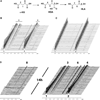Activity-based metabolomic profiling of enzymatic function: identification of Rv1248c as a mycobacterial 2-hydroxy-3-oxoadipate synthase
- PMID: 20416504
- PMCID: PMC2878197
- DOI: 10.1016/j.chembiol.2010.03.009
Activity-based metabolomic profiling of enzymatic function: identification of Rv1248c as a mycobacterial 2-hydroxy-3-oxoadipate synthase
Abstract
Activity based metabolomic profiling (ABMP) allows unbiased discovery of enzymatic activities encoded by genes of unknown function, and applies liquid-chromatography mass spectrometry (LC-MS) to analyze the impact of a recombinant enzyme on the homologous cellular extract as a physiologic library of potential substrates and products. The Mycobacterium tuberculosis protein Rv1248c was incompletely characterized as a thiamine diphosphate-dependent alpha-ketoglutarate decarboxylase. Here, recombinant Rv1248c catalyzed consumption of alpha-ketoglutarate in a mycobacterial small molecule extract with matched production of 5-hydroxylevulinate (HLA) in a reaction predicted to require glyoxylate. As confirmed using pure substrates by LC-MS, (1)H-NMR, chemical trapping, and intracellular metabolite profiling, Rv1248c catalyzes C-C bond formation between the activated aldehyde of alpha-ketoglutarate and the carbonyl of glyoxylate to yield 2-hydroxy-3-oxoadipate (HOA), which decomposes to HLA. Thus, Rv1248c encodes an HOA synthase.
(c) 2010 Elsevier Ltd. All rights reserved.
Figures







Comment in
-
Assigning enzyme function from the metabolic milieu.Chem Biol. 2010 Apr 23;17(4):313-4. doi: 10.1016/j.chembiol.2010.04.001. Chem Biol. 2010. PMID: 20416499 Free PMC article.
References
-
- Argyrou A, Blanchard JS. Mycobacterium tuberculosis lipoamide dehydrogenase is encoded by Rv0462 and not by the lpdA or lpdB genes. Biochemistry. 2001;40:11353–11363. - PubMed
-
- Brown SC, Kruppa G, Dasseux JL. Metabolomics applications of FT-ICR mass spectrometry. Mass Spectrom Rev. 2005;24:223–231. - PubMed
Publication types
MeSH terms
Substances
Grants and funding
LinkOut - more resources
Full Text Sources
Other Literature Sources
Molecular Biology Databases
Research Materials

